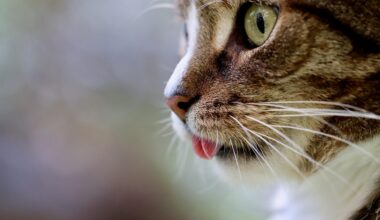The Role of Animal Control Agencies in Managing Feral Cats
Animal control agencies play a crucial role in managing the population of feral cats in urban and suburban environments. Feral cats, which are typically unsocialized and live primarily outdoors, can create various challenges for communities. These challenges include overpopulation, disease transmission, and negative impacts on local wildlife. Animal control agencies are often responsible for implementing programs that address these issues through humane trapping and sterilization. Their efforts aim not only to reduce the feral cat population but also to enhance public awareness regarding responsible pet ownership. Many communities have seen success in these programs when agencies collaborate with local veterinarians, rescue organizations, and volunteers. These collaborations can lead to more resources being available for spaying and neutering feral cats, thereby decreasing their reproduction rates and improving their overall health. By focusing on ethical management practices, animal control agencies help to mitigate the negative impacts of feral cat populations, promoting coexistence between cats and their surrounding ecosystems. Understanding the valuable role that these agencies play can help citizens appreciate their efforts and support future initiatives that aim to protect both cats and wildlife.
Additionally, the role of animal control agencies extends beyond just physical management of feral cat populations. They often engage in community education efforts aimed at fostering a more informed public regarding feral cat issues. Through outreach programs, workshops, and informational pamphlets, these agencies strive to increase awareness about the importance of spaying and neutering pets. Education also includes the consequences of feeding feral cats without sufficient management measures in place. When encouraged by humane education tactics, community members are more likely to support local animal control initiatives aimed at reducing feral cat populations. They may even participate in TNR (trap-neuter-return) programs that have demonstrated success in various regions. Education empowers the public to take actions that support responsible feral cat management, thereby reducing unwanted litters and improving overall cat welfare. Moreover, agencies often highlight the ecological impact feral cats can have on native wildlife. By connecting these points, animal control agencies can cultivate greater empathy for both feral cats and the animals they threaten, fostering cooperation among local citizens in managing feral cat populations effectively.
Furthermore, animal control agencies utilize various methods to control feral cat populations effectively. These methods can include the implementation of TNR programs, which focus on humanely trapping feral cats, neutering or spaying them, and then returning them to their original habitat. This method has gained significant popularity as it helps reduce the feral cat population over time while allowing them to continue living in the environment that they know. In addition to TNR, agencies may also enforce local ordinances that regulate the feeding of feral cats, thereby limiting their access to food sources. They might work with local governments to create designated feral cat colonies that are well-managed and monitored, ensuring that the cats receive consistent veterinary care and food. This approach not only benefits the feral cats but also helps to balance their impact on local wildlife. Agencies may also coordinate efforts with other organizations to create a robust network that supports feral cat management through funding, education, and research. Such collaboration enriches the effectiveness of feral cat management plans, resulting in a more sustainable approach to the challenges these animals present.
Challenges in Feral Cat Management
One significant challenge that animal control agencies face in managing feral cats is public perception. Many community members may view feral cats as cute or harmless, not recognizing the consequences of uncontrolled populations. This perception can lead to resistance against implementing management strategies such as TNR or feeding restrictions. Consequently, animal control agencies must work diligently to change public attitudes about feral cats by providing factual information regarding their ecological impact and public health risks. For example, free-roaming cats are known carriers of various zoonotic diseases that can be transmitted to other animals and humans. Addressing these concerns helps garner community support for feral cat management programs, paving the way for their success. Moreover, overcoming misconceptions about feral cats requires communication strategies that are both informative and compassionate. Animal control agencies need to acknowledge the emotional attachments people may have to feral cats, while effectively conveying the importance of responsible management to protect both the cats and local wildlife. Strong community relationships developed through transparency can lead to collaborative solutions that ensure the well-being of feral cats and the environment.
Another challenge involves coordinating efforts among multiple stakeholders in feral cat management. Animal control agencies often need to bring together a range of parties, including local governments, veterinarians, animal welfare groups, and volunteers. Each stakeholder may have differing priorities, which can complicate collaborative efforts. For instance, a local government may want to prioritize wildlife conservation while welfare groups or volunteers may focus exclusively on the welfare of feral cats themselves. Finding common ground among these diverse interests is essential for productive and sustainable management practices to emerge. Open dialogue among all stakeholders is crucial for identifying shared goals and developing a shared vision for feral cat management in the community. Strategies that emphasize cooperation, such as establishing regular meetings or forming working groups dedicated specifically to feral cat issues, can help streamline efforts. Additionally, sharing success stories from other communities that have successfully managed their feral cat populations can inspire and motivate stakeholders. Ultimately, a collaborative approach that focuses on the common good can enhance the effectiveness of feral cat management initiatives.
Moreover, funding limitations pose another significant barrier to effective feral cat management by animal control agencies. Many municipalities operate under tight budgets that may prioritize other pressing needs, resulting in limited resources for animal control operations. Consequently, agencies may struggle to secure adequate funding for vital programs like TNR, community education, and public outreach initiatives. This lack of funding can hinder the implementation of comprehensive feral cat management strategies that include proper medical care and long-term monitoring. However, animal control agencies can explore various funding sources to alleviate these financial constraints. Grant opportunities from animal welfare organizations, partnerships with local businesses, and crowdfunding efforts may provide additional resources needed to support their programs. Forming collaborative relationships with non-profit organizations dedicated to animal welfare can also help increase funding opportunities. By diversifying their funding sources, agencies can create more impactful programs that reach broader audiences. Ultimately, financial investment in feral cat management not only addresses the immediate concerns relating to feral cat populations but also fosters long-term solutions that benefit both the animals and communities at large.
Finally, keeping records and monitoring results is crucial when it comes to evaluating the effectiveness of feral cat management programs. This data collection can help animal control agencies assess the impact of their interventions and identify areas needing improvement. By analyzing statistics on population changes, health outcomes, and community engagement levels, agencies can better understand the effectiveness of various strategies. Continuous monitoring enables agencies to modify their approaches in real-time based on what is working and what is not. Additionally, documenting success stories can help communicate the positive impacts of feral cat management programs to the public. This transparency fosters trust and accountability among community members, encouraging their ongoing support for both current and future initiatives. Establishing strong feedback loops with stakeholders can further enhance the effectiveness of data-driven decision-making. By the continuous evaluation of feral cat management efforts, agencies can optimize their resources while making more informed choices. Ultimately, well-supported feral cat management programs lead to healthier populations of feral cats and improved ecological balance within the surrounding environment.


